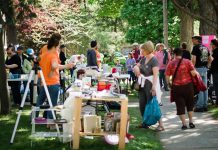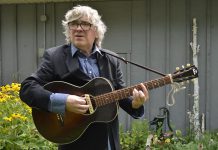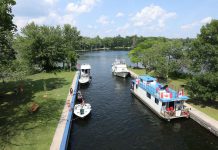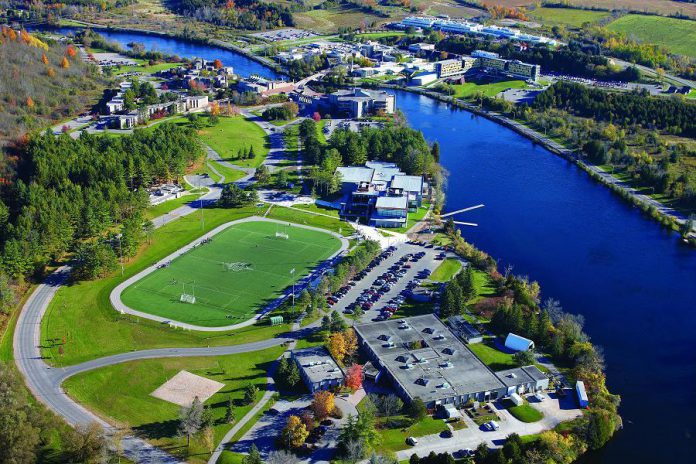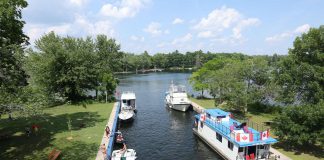This year marks the 50th anniversary of Trent University in Peterborough. Located on over 1,450 acres on the banks of the Otonabee River, Trent’s Peterborough campus is known for its award-winning architecture in a beautiful natural setting. With over 6,700 undergraduates in Peterborough (and more than 800 at its Oshawa location), Trent has been ranked as one of the top undergraduate universities in Canada. Known for leadership in teaching, research and student satisfaction, Trent attracts students from across the country and around the world. The university is particularly well-known for excellence and innovation in Canadian, indigenous, and environmental studies (with a strong focus on awareness and sustainability).
Part of Trent’s success over the past 50 years is because it was founded on the ideal of collaborative learning that’s personal, purposeful and transformative. Trent’s motto reflects the ideal of sharing knowledge: nunc cognosco ex parte (“Now I know in part”). Both undergraduate and graduate students at Trent collaborate with faculty, staff and peers through communities that span the university’s different colleges, classrooms, disciplines, hands-on research, co-curricular and community-based activities.
Through its 50th anniversary celebrations over the coming months and into 2015, Trent intends to reaffirm its leadership role and commitment to being a unique, relevant, and successful institution. The celebrations begin with the 50th Anniversary Alumni & Friends Reunion Kick-Off Weekend from Thursday, August 7th to Sunday, August 10th. The kick-off weekend features a series of events, including interactive panels with faculty and distinguished alumni and honorary degree recipients, a Blue Rodeo Concert, college and program reunions, and more.
On Friday, August 8th and Saturday, August 9th, Trent is also hosting the 2014 Ideas That Change the World Symposium, featuring over 75 of Trent’s most outstanding alumni and faculty as they converge to challenge thinking in the areas of education, indigenous peoples in Canada, sustainability and the environment, and more. Trent Chancellor Don Tapscott — a world authority on innovation, media, and the economic and social impact of technology — will deliver the symposium’s keynote address.
For a complete list of Trent events in 2014 and 2015, see our Trent University 50th Anniversary column or visit www.trentu.ca/fifty/.
Selected Highlights from Trent University’s 50-Year History
Trent University has an eventful and storied past. Did you know that the president of Quaker Oats called for the creation of a university in Peterborough? That Trent’s first president was the youngest person ever to become a university president in Canada? That the original editor-in-chief for Trent’s student-run newspaper went on to produce the Degrassi TV series? That iconic Canadian writer Margaret Laurence was Trent’s first Writer in Residence? Here are some selected highlights, including photos, of the past 50 years at Trent.
1956
The impetus for Trent University can be traced by a 1956 statement in the Ontario Legislature by Education Minister W.J. Dunlop, favouring the establishment of junior colleges in Ontario.
“We are preparing increased accommodation immediately in the seven universities of the province, and when we have been able to provide proper accommodation and make the necessary changes, with the co-operation of the universities, to enable us to take care of this increasing number, and when the universities have all they can properly take care of, then we will begin our programme of junior colleges.” – W.J. Dunlop
1957
In late 1957, Reginald R. Faryon, president of Quaker Oats at the time and a member of Trent’s original Board of Governors, writes a letter to the Peterborough Examiner calling for the creation of an institution of higher learning in Peterborough.
“Let us invest in something really big — the Junior College which will pay dividends for generations to come and benefit directly, or indirectly, every man, woman and child in Peterborough.” – Reginald R. Faryon
1961
The position of Trent’s first President is offered to Dr. Thomas Henry Bull Symons, a 33-year-old professor of History at the University of Toronto. Professor Symons was ranked top of a list of 40 candidates by Trent’s Academic Planning Committee (which includes the presidents of University of Toronto, University of Western Ontario, and Queen’s University). At first uncertain, after several meetings with the committee, Symons decides to accept the role of Canada’s youngest University President.

1962
Canadian General Electric donates 100 acres of property to the university. The parcel of land is named Nassau Mills after the historic saw mill established in 1854, by former Peterborough Mayor Charles Perry, on the current site of the university.
1963
Trent University receives its charter and is granted the power and authority to confer degrees. Thomas H.B. Symons is named president, and his passion for Canadian Studies and his commitment to fostering an intimate educational experience through the college system become the foundations of the fledgling university.
“The philosophy which inspires Trent is based upon the conviction that education is, inescapably, an individual experience. This philosophy … is reflected in the decision that Trent should be a collegiate university … In this way, through the colleges, members of the University may be helped to preserve a sense of individual identity as the University grows larger, and to find richer personal associations and a greater measure of academic assistance than would otherwise be the case.” – Thomas H.B. Symons
1964
Ontario Premier John Robarts announces the opening of a Trent University in Peterborough. Its initial enrollment is estimated at 100 students, to be increased to 250 students the following year. Robarts, who is also the Ontario Education Minister, announces that the government agrees to fund university expenditures of about $2 million from 1964-1966. The Premier says that the University will provide a broad range of degree programs in the arts and sciences.
The first students arrive at Trent in the fall of 1964, with the first classes being held at Rubidge Hall, now a retirement home on Rubidge Street.
Governor General Georges Vanier officially opens the university in October.
On the Sunday following Trent’s official opening ceremony, the university is opened to the public. A procession of distinguished visitors, representatives from universities across Canada, and students including Robert Lightbody, Andrew Robinson, and Rufus Gibbs marched through the university. The afternoon is spent listening to the Peterborough Civic Concert band, with tea served from the marquee at Rubidge Hall.
“This campus, comprising as it does some 1,500 acres of rolling and forested land, straddling the historic Otonabee River for nearly two miles, and on the very edge of the Canadian Shield, is surely one of the loveliest of any university in the world; and it holds open for the University the doors of opportunity to an exciting and unlimited future.” – Thomas H.B. Symons

1965
Marking the 350th anniversary of the journey of Samuel Champlain (who led his Huron allies down the Trent-Severn Waterway to attack the Iroquois on the south shore of Lake Ontario), the cornerstone of Champlain College, Trent’s first campus college, is laid. Fitting the naming of a college after a French explorer and Quebec hero, the cornerstone is laid by John Robarts, Premier of Ontario, and Jean Lesage, Premier of Quebec. Attending is an audience of 750 people, comprising faculty, staff and students of the university and members of city council, among others.

At the University’s opening ceremonies, Dr. Symons had announced his hope that Trent University would become a leader in the field of Canadian Studies. By May of 1965, Trent launches its first issue of the Journal of Canadian Studies, the very first of its kind. Now in its 37th year, the journal remains faithful to Dr. Symons’ vision.
“The most valid and compelling argument for Canadian studies is the importance of self-knowledge, the need to know and to understand ourselves.” – Thomas H.B. Symons
1966
Trent’s student-run newspaper Arthur is founded in 1966 by the first editor-in-chief, Stephen Stohn, who gives the paper its unusual name. Before settling on Arthur, the first three issues of the newspaper are called The Stentorian, Stoney Creek Gazette, and Nassau Times.
While many believe Stohn names the paper after the sword on the Trent crest — mistakenly believing it to be Excalibur, the legendary sword of King Arthur (in fact, it’s a representation of Samuel de Champlain’s sword) — Stohn later claims to have named the paper after a quote by George Harrison of The Beatles. In A Hard Day’s Night, Harrison is asked what his hairstyle is called and he answers “Arthur.”
Stohn, who is perhaps best known as executive producer of the popular television series Degrassi, also founded Trent Radio in 1968, and later went on to a career in the entertainment industry, winning 10 Gemini awards, two primetime Emmy nominations, and induction into the Canadian Music and Broadcast Industry Hall of Fame.

1967
While Trent has a reputation as a stand-out undergraduate university, graduate programs have been a part of the university’s offerings from the very start. Three students in the first academic year pursue postgraduate degrees, and the first convocation in 1967 sees the awarding of a Master of Science degree.
Beginning a tradition that continues to this day, Trent’s first convocation is held outside (there isn’t a room large enough for the more than 12 guests). Leslie Frost, former Premier of Ontario, is named Trent’s first Chancellor. Chancellor Frost speaks of his ties with Trent and on the development of education in Ontario, before capping the graduates and presenting the honorary degrees.

With Champlain College nearing completion, the students move in to their new rooms and tour the completed lecture hall, squash court, offices, dining hall, and college library. The new residents are greeted with evidence of a night’s visit by the Traill College women, in the form of handwritten signs and a symbolic bottle of champagne left in the dining hall in commemoration of the college’s opening. Each Champlain student finds study-bedrooms, already complete with electric heating, bookshelves, desk, telephone, and closet space. The students are impressed with the modern Danish furniture, comfortable beds, and the sweet smell of the cedar ceiling.

1968
Reeves Glen Brown of Douro Township and James Rea of Smith Township open Faryon Bridge, Trent’s bridge across the Otonabee, the central axis of the Nassau campus. The bridge is named after Reginald Faryon, former President of Quaker Oats of Canada, who gave early thought to the idea of a university in Peterborough in a letter in the Peterborough Examiner in 1958 (Faryon died in 1962).

1969
The Thomas J. Bata Library opens in September. Designed by award-winning modernist architect and Trent master planner, Ron Thom, the building is made possible by a generous donation from well-known industrialist Thomas Bata, an early Trent Board member and the founder of Bata Shoes. Trent’s previous library was housed in Rubidge Hall and simply had insufficient space to support the needs of a university. The new library is designed to be a crossroads of pedestrian traffic, to hold up to 370,000 volumes, and include language labs, a small film screening room, an A.V. department, and a rare books and special collections archive.
“The library is considered to be the central building of the campus … the proper hub of the University. The main academic square is at the front door of this main building and will become the gathering point of the campus. It will occupy the same place in the lives of the University community that the village square does in the lives of its community.” – Ron Thom

Chancellor Leslie Frost opens Lady Eaton College, Trent’s second Nassau Campus college. The $3.5 million residential and teaching college houses about 237 women, graduate students, and teaching and administrative fellows. Members of the Eaton family are present along with government, university, and city officials.

Trent University becomes the first university in Canada — and only the second in North America — to establish a department dedicated to the study of Aboriginal Peoples. Co-founded by Dr. Harvey McCue of the Georgina Island First Nations and Dr. Tom Symons, the Indian-Eskimo Studies Program (now Indigenous Studies) leads the way for other programs in Canada.
“It seems to me that teaching and research by and for the Indigenous peoples is fundamental to our understanding about Canada.” – Thomas H.B. Symons
1971
The founder of the Trent University Rowing Club, Chris Leach, organizes the first Head of the Trent regatta in 1971. Today, Head of the Trent is North America’s largest single-day, head-race regatta, comprising over 1,200 athletes from over 50 universities and clubs across Canada and the northern United States.

1972
Trent University creates the Canadian Studies department, with Professor Alan Wilson serving as the first chair of the department until 1984.
President Symons ends his 11-year term as President and Vice-Chancellor of Trent University. Amidst rumours of his intention to run for parliament, he takes up the position of President of the Canadian Association in Support of Native Peoples, and head of a commission to examine the teaching and knowledge of Canada in the nation’s universities. This second appointment results in the famous and influential To Know Ourselves report, which alters hiring practices across Canada and leads to the establishment of a number of Canadian Studies departments. President Symons is also named honorary President of the Trent University Alumni Association at this time.
1973
Trent’s fifth college, officially named Otonabee College (after various other names were considered), opens in the fall of 1973, with philosopher Robert E. Carter its first master. The college is built jutting out of the hillside behind the Science Building, with space for co-ed accommodation of 340 students, a dining hall, labs, seminar and common rooms, and a 350-seat lecture theatre.
1974
Trent University starts Canada’s first Indigenous Studies program in 1974 (known at the time as the Department of Indian and Eskimo Studies). It is the oldest discipline of its kind and has evolved into several new and unique academic programs, giving Trent a well-established reputation for excellence and innovation in the field Indigenous Studies. Trent’s innovative degree programs such as Indigenous Environmental Studies and the M.A. in Canadian Studies and Indigenous Studies are embedded in that legacy, drawing on faculty from the humanities, social sciences and other interdisciplinary fields.

Award-winning and iconic Canadian writer Margaret Laurence becomes Trent’s first Writer in Residence at Champlain College. In early 1974, Laurence is joined by 11 notable Canadian authors (Al Purdy, Graeme Gibson, George Johnston, Robert Finch, Alice Munro, Robertson Davies, W.O. Mitchell, Richard Wright, John Newlove, A.J.M. Smith and Tom Marshall) at a literary gala. Later that year, Laurence goes on to win the Governor-General’s Award for Fiction for the last in her Manawaka series, The Diviners.
“I looked at the tall angularity of a few finely proportioned buildings, grey but not austere, standing castle-like in the diamonded snow of a clear January day, and at the river, crusted ice and darkly shining water, flowing so closely that it appeared almost to be winding in and through the buildings, a part of them, or they a part of it. That was my first view of Trent, some years back. I realized I’d never before seen a campus which looked so beautiful in the winter.” – Margaret Laurence

Trent University creates the Environmental and Resource Studies Program as a strategic interdisciplinary program.
1975
Poet Dennis Lee, author of the Governor-General’s award-winning Civil Elegies, joins the new community of Otonabee College as Writer in Residence, to read from his newly completed Alligator Pie and to edit Moving to the Clear, an anthology of work by Trent writers.

1980
Ron Thom is awarded the Order of Canada. The mastermind behind Trent’s original design, Thom is recognized as one of Canada’s premier architects. Built in the modernist style, Thom’s design of Trent University extends to furniture, draperies, and fittings.
“The physical character of a university must reflect its philosophical idea. Buildings superimposed on this framework can contradict the idea, or merely reflect it, or, ideally, extend and expand it.” – Ron Thom

1982
Jack Matthews founds the Trent International Program (TIP). A visionary international educator who also founded Pearson United World College in British Columbia, the Canadian Canoe Museum, and was a Headmaster of Lakefield College School, Matthews’s commitment to the development of student leadership in the interest of global citizenship is the foundation of the Trent International Program. Today, with more than 550 international students from 95 different countries, Trent is distinct for its varied and thriving international community.

1998
Dr. Bradley White moves his Wildlife Forensic DNA lab to Trent University. From the prevention of poaching in northern Ontario to the preservation of habitats off the coasts of Taiwan and Hong Kong, Dr. White uses cutting-edge DNA technology to bring about change at home and abroad.
“It all comes together here, because DNA is the first and most important information technology.” – Dr. Bradley White
2001
The PhD program in Canadian Studies accepts its first students. Offered jointly by the Frost Centre for Canadian Studies and Indigenous Studies at Trent and the School of Canadian Studies at Carleton University, the joint PhD remains the only fully interdisciplinary doctoral program in Canadian Studies in Canada.
Dr. Bradley White’s Wildlife Forensic DNA team is awarded a tier one Canada Research Chair to further their studies.
2004
Trent master architect Ron Thom’s modular design grows to include two new prominent buildings: the Chemical Science building (winner of a Governor General’s medal) and Enweying, the Peter Gzowski College and First People’s House of Learning. The iconic roofs of both buildings are designed as green spaces used both for research on the effects of ground level ozone on crops, and for growing vegetables and herbs that are harvested and used in food production in the campus’s Seasoned Spoon Café.
“For me, Gzowski College and the building, Enweying, represent the best of Trent. We have the geography (great views of the Otonabee River), the architecture (a building designed to honour the land and to encourage collaborative partnerships) and the history (we share the building with the First Peoples House of Learning and we’re named after Peter Gzowski, a Canadian icon and a past Trent Chancellor).” – Dr. Melanie Buddle

2006
The long-standing relationship between the Ministry of Natural Resources (MNR) and Trent University is cemented with the opening of Trent’s new $20-million DNA building. More than 50 MNR staff make the move to campus to work alongside Trent students and faculty. The building represents the first phase in a larger plan for a multi-partner, regional DNA cluster.
“The DNA Cluster represents the future for the County and City of Peterborough. Research and innovation will be the backbone for future economic growth. This is world-class facility-building on the strengths of a world-class community.” – Jeff Leal, Peterborough MPP and Parliamentary Assistant to the Minister of the Environment

2007
Trent athletics opens its state-of-the-art stadium, complete with artificial turf, outdoor sound system and score board, press box able to support live broadcasts and web-casting, and bleacher seating for 1,000. Approximately 200,000 people use the stadium each year. In 2010, the stadium is named in honour of Justin Chiu, a Trent alumnus and world-renowned property developer.

2010
Civic leaders join with Trent University students, faculty, staff and board members in Oshawa to celebrate the official opening of the new Trent University Oshawa Thornton Road campus. The new $11.5 million facility will deliver full-time and part-time programs to over 1,600 students during the next seven years. The Thornton Road campus builds on Trent’s presence in the Durham region, which dates back 40 years.

2011

Rising in the rankings over the previous year among 19 primarily undergraduate institutions nationally, Trent also ranks number one in the key categories of Scholarships and Bursaries, Awards Per Full-Time Faculty, and Medical and Science Grants.
“We are leading in key categories that are highly valued by students and their parents — and that bodes well for the future as Trent approaches its 50th anniversary year.” – Dr. Steven Franklin, president and vice-chancellor of Trent, 2009-2014
2013
For the fourth year in a row, Trent is named a leader in the Globe and Mail University Report for Environmental Commitment category for small universities (1st in 2010, 2nd in 2011 and 1st in 2012, Grade A in 2013). In June of 2013, Trent is also highlighted among the list of Ontario universities committed to the environment and environmental sustainability by the Council of Ontario Universities (COU) in its fourth annual Going Greener report.
All photos courtesy of Trent University, except where noted.



